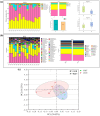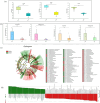Fecal microbiota transplantation improves Sansui duck growth performance by balancing the cecal microbiome
- PMID: 40593020
- PMCID: PMC12218183
- DOI: 10.1038/s41598-025-04942-0
Fecal microbiota transplantation improves Sansui duck growth performance by balancing the cecal microbiome
Abstract
Improving growth performance is vital in poultry production. Although several studies have established associations between gut microbiota and growth, the direct impacts remain unclear. A total of 120 1-day-old Sansui ducks were randomly assigned to the FMT and CON groups. From the 1st day, ducks in the FMT group were orally administrated with 0.5 mL fecal microbiota suspension for three consecutive days, while sterile PBS solution was used as a substitute in the CON group. The results revealed that FMT improved average daily gain (ADG) (P < 0.001) and body weight (BW) (P < 0.001), with a tendency for a better feed conversion rate (FCR) (P = 0.062). LEfSe analysis indicated a significant increase in the abundance of the Lactobacillus (P < 0.001), Bifidobacterium (P = 0.006), Megamonas (P = 0.008), and Subdoligranulum (P = 0.005) in the FMT group. Similarly, the phyla Firmicutes/Bacteroidetes ratio was higher in the FMT group compared to the CON group. Additionally, the ACE, Chao, and Shannon indices were also significantly higher in the FMT group (P < 0.001). To sum up, FMT enhanced growth performance, which could be associated with reducing proinflammatory pathogen colonization in the duck cecum. This modulating effect likely results from increased microbial diversity and the enrichment of beneficial bacteria.
Keywords: Cecal microbiota; Fecal microbiota transplantation; Growth performance; Sansui ducks.
© 2025. The Author(s).
Conflict of interest statement
Declarations. Competing interests: The authors declare no competing interests. Ethical approval: This experiment was approved by the Animal Ethics Committee of Guizhou University (No. EAE-GZU-2020-E012). We confirm that all methods were performed under relevant guidelines and regulations. Additionally, we confirm that we have fully complied with the latest version of the ARRIVE guidelines in this study.
Figures




Similar articles
-
The protective effects of dietary resistant starch against post-antibiotic bone loss in meat ducks associated with the recovery of caecal microbiota dysbiosis.Poult Sci. 2025 Aug;104(8):105238. doi: 10.1016/j.psj.2025.105238. Epub 2025 May 1. Poult Sci. 2025. PMID: 40424882 Free PMC article.
-
Fecal microbiota transplantation for the treatment of recurrent Clostridioides difficile (Clostridium difficile).Cochrane Database Syst Rev. 2023 Apr 25;4(4):CD013871. doi: 10.1002/14651858.CD013871.pub2. Cochrane Database Syst Rev. 2023. PMID: 37096495 Free PMC article.
-
Fecal microbiota transplantation improves growth performance of chickens by increasing the intestinal Lactobacillus and glutamine.Poult Sci. 2025 Aug;104(8):105243. doi: 10.1016/j.psj.2025.105243. Epub 2025 May 1. Poult Sci. 2025. PMID: 40398303 Free PMC article.
-
FMT reduces systemic inflammatory response in severe acute pancreatitis by increasing the abundance of intestinal Bifidobacteria and fecal bacteria.Biomol Biomed. 2025 May 8;25(7):1591-1600. doi: 10.17305/bb.2024.11445. Biomol Biomed. 2025. PMID: 39764653 Free PMC article.
-
Fecal Microbiota Transplantation in Irritable Bowel Syndrome: A Systematic Review and Meta-Analysis of Randomized Controlled Trials.Int J Mol Sci. 2023 Sep 26;24(19):14562. doi: 10.3390/ijms241914562. Int J Mol Sci. 2023. PMID: 37834010 Free PMC article.
References
-
- Vasai, F. et al. Lactobacillus sakei modulates mule Duck microbiota in ileum and Ceca during overfeeding. Poult. Sci.93, 916–925. 10.3382/ps.2013-03497 (2014). - PubMed
MeSH terms
Grants and funding
LinkOut - more resources
Full Text Sources
Miscellaneous

